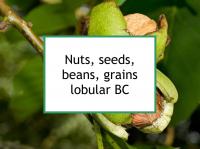The current webpage makes additional research available concerning how various nuts, seeds, beans (if any) and grains or their major bioactive components improve lobular breast cancer risk, development, and prognosis. At the bottom of this webpage are links to studies relating to the beneficial nuts, seeds, and grains listed listed in Foods to eat and avoid for lobular breast cancer patients & survivors.
There are very few studies that directly investigate the influence of nuts, seeds, and grains or their components on lobular breast cancer since there are no experimental lobular breast cancer cells. However, since lobular breast cancer typically is characterized by greatly reduced expression of E-cadherin (a protein that facilitates cell-to-cell adhesion), nuts, seeds, and grains have the potential to inhibit lobular disease through the actions of compounds that increase E-cadherin expression. These include soluble dietary fiber, the gamma-tocotrienol form of vitamin E, the hormone melatonin and the polyphenol quercetin:
- Soluble fiber (found, for example, in flaxseed, oats, rye bran, walnuts, wheat bran)
- Gamma-tocotrienol (brown rice)
- Melatonin (black or red rice, pistachio nuts)
- Quercetin (buckwheat)
Please read the applicable food webpages when making your own food lists since these pages contain important advice, food rankings (e.g., highly recommended, recommended in moderation), consumption limits, and other pertinent information.
The beneficial compounds listed above should be obtained by eating the applicable nuts, seeds, or grains rather than taking supplements. When a beneficial micronutrient is administered at low doses by consuming food, it is likely to have subtle chemopreventive effects, whereas the same compound administered at high doses is more likely to have pharmacological effects, with possible unwanted outcomes. For example, quercetin has been reported to contribute to the growth of estrogen-induced mammary tumors once the tumors were established in female rats.
